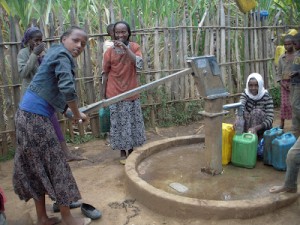The water available in or near your home can vary dramatically over short distances. In Manchester, there is a robust supply of fresh water from the Lake District, whereas in London (only 200 miles away) the water has passed through limestone, leaving it with a cloudy taste and causing limescale build-up. Signs up on the London underground at the moment are encouraging people to save water by taking the “4 minute shower challenge” and this summer we have had a series of localised droughts and floods. Food prices are expected to rise because there was too much rain this summer, leading to widespread crop failure. Even in the UK, where we have plenty of year-round rainfall, controlling the quantity and quality of water is an expensive and precarious business.
It was in London that the connection was first made between water and health. John Snow noticed that the cholera outbreak in Soho was being caused by a contaminated water supply from the broad street well. In the UK there is now a secure and safe water supply. However, the water available to people around the world is much more variable. Over two million deaths a year are caused by poor water hygiene – equivalent to AIDS or malaria.
The primary control on precipitation (water that falls as rainfall, sleet or snow) is the large-scale convection cells in the atmosphere, which vary systematically with latitude – are you in a tropical zone or a desert zone? Groundwater levels, however, follow more complex patterns. Groundwater maps of Africa produced by a team at UCL show surprising levels of groundwater in unexpected places, such as deep beneath the sahara desert. The primary control on the quality of water is often geological – what rock and sediment does the water pass through between the source and the point of access?

NASA’s landsat educational archives: Latitudinal bands of tropics and deserts across the globe are driven by large scale atmospheric circulation cells.
In developing countries projects often have to work on a local scale, because there is no centralised water supply. Lack of access to water often has a disproportionate impact on women, who are normally expected to walk long distances to collect water from uncontaminated wells. Babies and small children are then the most vulnerable to health problems if the water supply is contaminated. Provision of clean water is the single most important factor in reducing infant mortality.

Clean groundwater is being extracted from a deep borehole in Ethiopia – giving local communities a better chance of staying healthy. (c) Geology for Global Development 2012
Surface water is more susceptible to contamination from bacteria, but groundwater is more susceptible to heavy metal contamination. Two of the most worrying contaminants are Fluoride and Arsenic, and we will discuss each of these in depth in future blog articles. GfGD has discussed problems relating to water supply in the past, such as our winning entry in last years blog competition, and Donald John MacAllister’s guest blog sharing his practical experience in Bangladesh. Look out for more on our ‘water series’ over the coming weeks.



